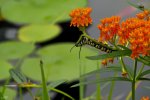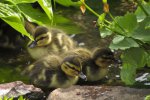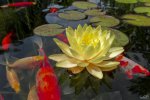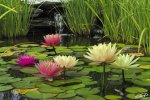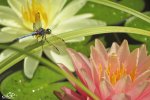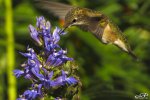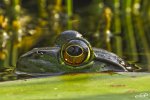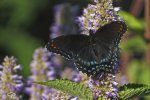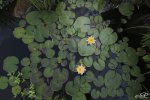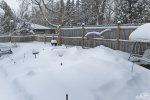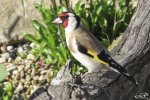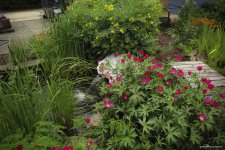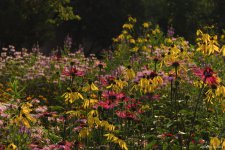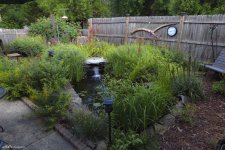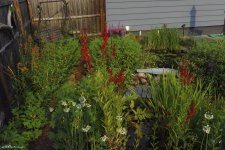Overview
Welcome to my pond!

In 2014, I designed and built my 800 gallon pond after 4 years of having smaller ponds. I added the pond and its surrounding native plant garden spaces in an attempt to attract more wildlife to my yard. In addition to the pond, I added a bog filter, which would double as additional wetland habitat. In 2018, I expanded the garden area to nearly double the previous size, now including a rain garden, a shade garden, and some additional garden space. You can see my layout in the graphic below.

I originally built a pond in hopes of attracting frogs to my yard. While frogs did quickly appear, I also learned that the pond would attract a lot more than just frogs. Birds fly in often to drink and bathe in my bog, and I've even had Mallard Ducks nest next to my pond. Dragonflies and damselflies have become a common sight. When I started adding native plants, I started seeing even more wildlife. Butterflies of a dozen or more species can be seen throughout my yard all summer long, and ruby-throated hummingbirds are also frequent visitors now that I've added some of their favorite nectar sources, including Cardinal Flower and Great Blue Lobelia, which both grow in my bog filter.





While the project was originally focused on attracting wildlife, the focus has since shifted toward helping wildlife. While that might sound like the same thing, attracting wildlife was more about me than it was about the them. I wanted to see them for my own personal benefit. Now, my focus is heavily on providing for wildlife and giving them a place to reliably find food, shelter, and nesting material. I've learned a lot about native plants over the past decade+, and I've used what I've learned to plant some of the best possible species to help wildlife in my area, starting with multiple species of Milkweed to help Monarch butterflies, but also planting a wide variety of other host plants and nectar plants.



Here are some more photos taken around my pond:








Beyond the pond, I've also added 3000 sq. ft. of native garden habitat that includes 80 native plant species, as well as 7 nesting boxes built for House Wrens. Many butterfly species can be seen drinking nectar or laying eggs on host plants. Bees of all kinds, including endangered rusty-patched bumble bees, can be seen going from flower to flower drinking nectar and collecting pollen, or laying eggs in hollow stems. Frogs and toads can be seen on the ground looking for their next meal. While my pond has been a lot of fun, the native gardens are what I'm most proud of. It's truly a miniature habitat restoration that is desperately needed for so many species.

In 2014, I designed and built my 800 gallon pond after 4 years of having smaller ponds. I added the pond and its surrounding native plant garden spaces in an attempt to attract more wildlife to my yard. In addition to the pond, I added a bog filter, which would double as additional wetland habitat. In 2018, I expanded the garden area to nearly double the previous size, now including a rain garden, a shade garden, and some additional garden space. You can see my layout in the graphic below.
I originally built a pond in hopes of attracting frogs to my yard. While frogs did quickly appear, I also learned that the pond would attract a lot more than just frogs. Birds fly in often to drink and bathe in my bog, and I've even had Mallard Ducks nest next to my pond. Dragonflies and damselflies have become a common sight. When I started adding native plants, I started seeing even more wildlife. Butterflies of a dozen or more species can be seen throughout my yard all summer long, and ruby-throated hummingbirds are also frequent visitors now that I've added some of their favorite nectar sources, including Cardinal Flower and Great Blue Lobelia, which both grow in my bog filter.
While the project was originally focused on attracting wildlife, the focus has since shifted toward helping wildlife. While that might sound like the same thing, attracting wildlife was more about me than it was about the them. I wanted to see them for my own personal benefit. Now, my focus is heavily on providing for wildlife and giving them a place to reliably find food, shelter, and nesting material. I've learned a lot about native plants over the past decade+, and I've used what I've learned to plant some of the best possible species to help wildlife in my area, starting with multiple species of Milkweed to help Monarch butterflies, but also planting a wide variety of other host plants and nectar plants.
Here are some more photos taken around my pond:
Beyond the pond, I've also added 3000 sq. ft. of native garden habitat that includes 80 native plant species, as well as 7 nesting boxes built for House Wrens. Many butterfly species can be seen drinking nectar or laying eggs on host plants. Bees of all kinds, including endangered rusty-patched bumble bees, can be seen going from flower to flower drinking nectar and collecting pollen, or laying eggs in hollow stems. Frogs and toads can be seen on the ground looking for their next meal. While my pond has been a lot of fun, the native gardens are what I'm most proud of. It's truly a miniature habitat restoration that is desperately needed for so many species.
Fish / Plant Stock
PLANTS:
I've compiled a complete list of all plant species in my entire yard (as of March 2025). I've highlighted species that are specifically grown in my bog and pond.

COMMON WILDLIFE IN MY YARD:
Amphibians
- American Toad
- Bullfrog
- Green Frog
- Northern Leopard Frog
- Western Chorus Frog
Bees
- Bumble Bee sp. (including endangered Rusty-patched bumble bees)
- Carpenter Bee sp.
- Leafcutter Bee sp.
- Longhorn Bee sp.
- Sweat Bee sp.
Birds
- American Goldfinch
- American Robin
- Black-capped Chickadee
- Blue Jay
- Downy Woodpecker
- Great Horned Owl
- House Finch
- House Wren
- Mallard Ducks
- Mourning Doves
- Northern Cardinal
- Northern Orioles
- Red-bellied Woodpecker
- Red-breasted Nuthatch
- Ruby-throated Hummingbirds
- White-breasted Nuthatch
Butterflies
- Black Swallowtail
- Cabbage White
- Clouded Sulphur
- Eastern Tiger Swallowtail
- Monarch
- Painted Lady
- Red Admiral
- Red-spotted Purple
- Silver-spotted Skipper
- Spring/Summer Azure
Damselflies & Dragonflies
- Autumn Meadowhawk
- Blue Dasher
- Common Whitetail Skimmer
- Eastern Amberwing
- Eastern Forktail
- Eastern Pondhawk
- Orange Meadowhawk
- Twelve-spotted Skimmer
- Widow Skimmer
Fish
- Goldfish (non-native)
Mammals
- Eastern Chipmunk
- Eastern Cottontail Rabbit
- Eastern Gray Squirrel
- Groundhog
- Raccoon
- Virginia Opossum
- White-tailed Deer
I've compiled a complete list of all plant species in my entire yard (as of March 2025). I've highlighted species that are specifically grown in my bog and pond.

COMMON WILDLIFE IN MY YARD:
Amphibians
- American Toad
- Bullfrog
- Green Frog
- Northern Leopard Frog
- Western Chorus Frog
Bees
- Bumble Bee sp. (including endangered Rusty-patched bumble bees)
- Carpenter Bee sp.
- Leafcutter Bee sp.
- Longhorn Bee sp.
- Sweat Bee sp.
Birds
- American Goldfinch
- American Robin
- Black-capped Chickadee
- Blue Jay
- Downy Woodpecker
- Great Horned Owl
- House Finch
- House Wren
- Mallard Ducks
- Mourning Doves
- Northern Cardinal
- Northern Orioles
- Red-bellied Woodpecker
- Red-breasted Nuthatch
- Ruby-throated Hummingbirds
- White-breasted Nuthatch
Butterflies
- Black Swallowtail
- Cabbage White
- Clouded Sulphur
- Eastern Tiger Swallowtail
- Monarch
- Painted Lady
- Red Admiral
- Red-spotted Purple
- Silver-spotted Skipper
- Spring/Summer Azure
Damselflies & Dragonflies
- Autumn Meadowhawk
- Blue Dasher
- Common Whitetail Skimmer
- Eastern Amberwing
- Eastern Forktail
- Eastern Pondhawk
- Orange Meadowhawk
- Twelve-spotted Skimmer
- Widow Skimmer
Fish
- Goldfish (non-native)
Mammals
- Eastern Chipmunk
- Eastern Cottontail Rabbit
- Eastern Gray Squirrel
- Groundhog
- Raccoon
- Virginia Opossum
- White-tailed Deer

